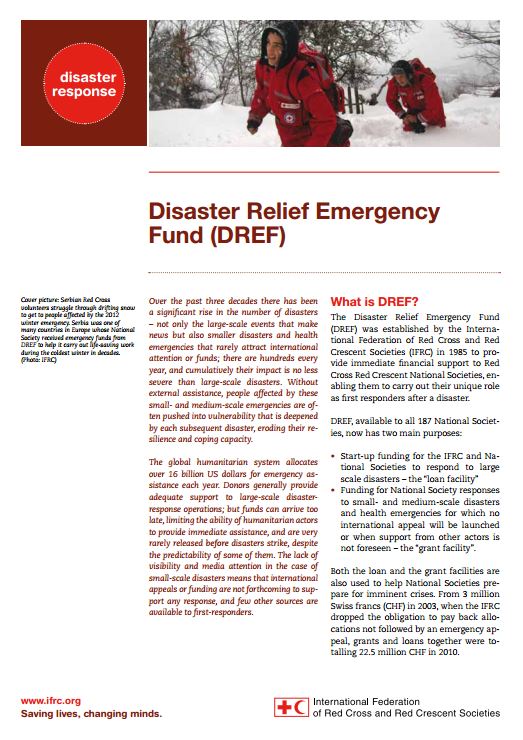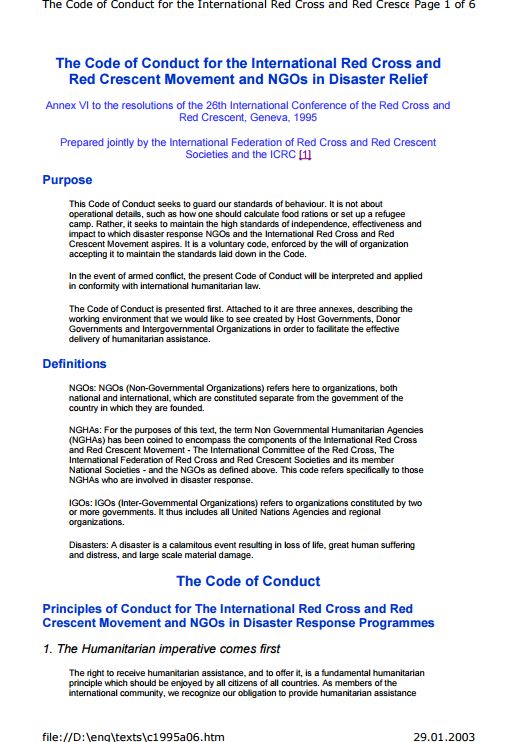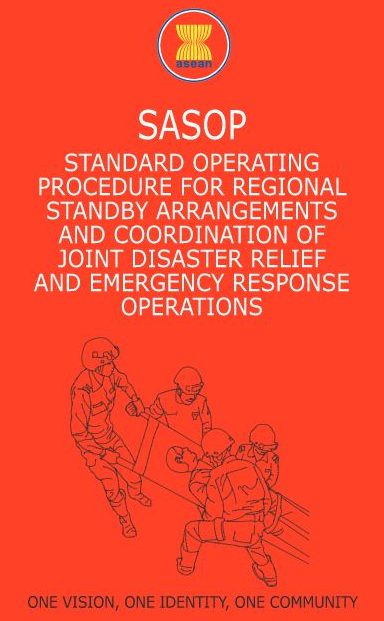RDRT Update as of July 2012
Purpose and overview:
The document offers an overview of RDRT as of July 2012, and direction of travel as well as way forward (standardization of roster categories).
The following are the expected roles from National Societies and IFRC:
![]()
Disaster Relief Emergency Fund (DREF)
Purpose:
The document serves as a background paper on the Disaster Relief Emergency Fund (DREF), what it is and what it is for, as well as comparing DREF and the global humanitarian system, and an overview of the funding per type of disaster from 2002 – 2011.
Overview:
The document includes case studies:
- Kosove coldwave
- Myanmar storm
- Niger population movement
- Uganda epidemics
Usage: Guide for implementation
Audience: IFRC and National Societies staff
![]()
Sphere Handbook
Purpose:
The Sphere Handbook is a voluntary code and a self-regulatory tool for quality and accountability, and the Sphere Project does not operate any compliance mechanism.
The Handbook does not offer practical guidance on how to provide certain services (the key actions suggest activities to reach a standard without specifying how to do that). Rather, it explains what needs to be in place in order to ensure a life with dignity for the affected population.
The Sphere Project or ‘Sphere’, initiated in 1997 by a group of humanitarian non-governmental organisations (NGOs) and the International Red Cross and Red Crescent Movement, with the aim was to improve the quality of their actions during disaster response and to be held accountable for them.
Sphere is based on two core beliefs:
- First, that those affected by disaster or conflict have a right to life with dignity and, therefore, a right to assistance;
- Second, that all possible steps should be taken to alleviate human suffering arising out of disaster or conflict.
Striving to support these two core beliefs, the Sphere Project framed a Humanitarian Charter and identified a set of minimum standards in key lifesaving sectors which are now reflected in the Handbook’s four technical chapters: water supply, sanitation and hygiene promotion; food security and nutrition; shelter, settlement and non-food items; and health action.
The Core Standards are process standards and apply to all technical chapters.
Overview:
How to use the standards:
- The Core Standards and minimum standards follow a specific format. They begin with a general and universal statement – the minimum standard – followed by a series of key actions, key indicators and guidance notes.
- All the chapters are interconnected. Frequently, standards described in one sector need to be addressed in conjunction with standards described in others.
See also: http://www.spherehandbook.org/
![]()
Code of Conduct for the International Red Cross and Red Crescent Movement and NGOs in Disaster Relief
Purpose:
This Code of Conduct seeks to guard our standards of behaviour. It is not about operational details, such as how one should calculate food rations or set up a refugee camp. Rather, it seeks to maintain the high standards of independence, effectiveness and impact to which disaster response NGOs and the International Red Cross and Red Crescent Movement aspires. It is a voluntary code, enforced by the will of organization accepting it to maintain the standards laid down in the Code.
In the event of armed conflict, the present Code of Conduct will be interpreted and applied in conformity with international humanitarian law.
The Code of Conduct forms Annex VI to the resolutions of the 26th International Conference of the Red Cross and Red Crescent, Geneva, 1995, and was prepared jointly by the IFRC and ICRC.
Overview:
The Code’s ten principles highlight, among other things, the right of disaster-affected populations to receive humanitarian assistance without discrimination and the crucial role played by women in disaster-prone communities. Emphasis is also placed on protecting and preserving the dignity of beneficiaries.
The Code has three annexes containing recommendations for governments of disaster-affected countries, donor governments and intergovernmental organizations. The general thrust of these recommendations is the need to ensure rapid access to disaster victims, timely delivery of appropriate assistance and respect for the independence and impartiality of humanitarian organizations.
Usage: Behavior guidelines
Audience: National Society staff and volunteers
See also: Principles and Rules for Red Cross and Red Crescent Humanitarian Assistance [pdf, 0.2 MB]
![]()
ASEAN’s Standard Operating Procedure for Regional Standby Arrangements and Coordination of Joint Disaster Relief and Emergency Response Operations – SASOP
Purpose:
ASEAN Member States signed the ASEAN Agreement on Disaster Management and Emergency Response (AADMER) on 26 July 2005 in Vientiane, Lao PDR. The Agreement seeks to provide effective mechanisms to achieve substantial reduction of disaster losses in the social, economic, and environmental assets of the Parties, and to jointly respond to disaster emergencies through concerted national efforts and intensified regional and international cooperation.
To ensure preparedness for effective response, AADMER requires for the establishment of the ASEAN Standby Arrangements for Disaster Relief and Emergency Response where Parties, on a voluntary basis, shall identify and earmark assets and capacities which may be made available and mobilised for disaster relief and emergency response.
AADMER also requires the preparation of this Standard Operating Procedure (SOP) that shall guide the actions of Parties and the ASEAN Coordinating Centre for Humanitarian Assistance on disaster management (AHA Centre) in implementing:
- The regional standby arrangements for disaster relief and emergency response;
- The utilisation of military and civilian personnel, transportation and communication equipment, facilities, good and services, and the facilitation of their trans-boundary movement;
- The co-ordination of joint disaster relief and emergency response operations.
Overview:
This SOP provides:
- The guides and templates to initiate the establishment of the ASEAN Standby Arrangements for Disaster Relief and Emergency Response,
- The procedures for joint disaster relief and emergency response operations,
- The procedures for the facilitation and utilisation of military and civilian assets and capacities,
- The methodology for the periodic conduct of the ASEAN regional disaster emergency response simulation exercises (ARDEX) which shall test the effectiveness of this procedure.
Usage: Guidance for disaster response
![]()








